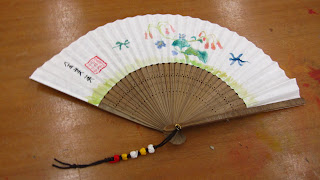 | ||
| A bajillion lotus flowers grow next to the Han River at 두물머리. |
Recently, a commenter on another post asked if I really recommend staying with my host family. So today, I'm going to talk a little more about my home-stay experience. To begin with, I found my host family through korea-homestay.com. (There are other home-stay companies in Korea, including the confusingly similar-sounding homestaykorea.com, but I haven't had any personal experience with them. My dealings with the korea-homestay staff, at any rate, have been pleasant and
satisfactory; their English is less than perfect, but that usually
doesn't cause problems.) I don't know whether I got lucky or my experience is typical for a home-stay guest, but I have been living very comfortably and getting along very well with my hosts. My family consists of a host mom, host dad, and their middle-school aged daughter, besides which a couple of other home-stay guests have also joined us at various times. I get plenty of privacy in my own bedroom, and I interact with the family mostly around mealtimes, but I also have been studying Korean/teaching English with the daughter for an hour or so most nights. Speaking of meals, breakfast is included in the regular home-stay price, but since I also have dinner with the family almost every day, I paid for that in a lump sum at the beginning of my stay (assuming an average of $10 per dinner).
 |
| The two rivers meeting at 두물머리 |
For me, one of the perks of doing home-stay was that it gave me a place to practice violin. More generally, unless you are the super-social type who makes friends easily wherever you go, having a home-stay family can help plug you into a Korean community from the get-go, and give you connections you wouldn't have otherwise. For example, I've also been hanging out with another family from the same apartment building, who are friends my host family. I've had dinner and lunch at their place, read Harry Potter with their daughter, and even tagged along on a car trip to 두물머리 (the place where the North Han River and South Han River meet). My hosts are also happy to help me out with my language study and homework whenever I ask (which helps me not to feel the lack of the tutor that Ewha said it would provide and never did).
My host family also happens to be in a very nice neighborhood, which is safe at night, has a library and shopping mall within easy walking distance, a subway station 5 minutes away by foot, and great views of mountains and the Han River (which like the subway station is just a 5 minute walk away from the apartment). The only disadvantage to the location, for me, is that it is a pretty good distance from Ewha - I have to give myself 50 minutes to an hour to get to school (though the actual subway ride is only 20ish minutes).
So far, home-stay probably sounds like a great deal, and for the most part, it is. For those who are wondering if they should go for it, though, I do have a couple of caveats/things to keep in mind. First, it might be difficult to find a suitable family in the first place - I got lucky in that my host found me first and turned out to be great, but one of my friends had to give up on finding a host and ended up living (very happily) in a hasukjib. So don't forget about other living options. Second, don't underestimate commuting distance. I've gotten used to my commute, but I won't deny that I've often wished I lived closer to school (and the rest of my friends). Third, it's best if you come with at least a basic command of Korean to begin with; that'll make life easier for everyone involved (unless you happen to find a host with an excellent command of English or your native language).
Home-stay is also more expensive than a typical hasukjib or other student accommodation. The baseline fee for me (with a student discount) was $550/month, not counting the $700 lump sum I paid in addition for 70 days' worth of dinners. If you're okay with the pricing, though, I definitely encourage you to look into doing home-stay. It's totally free to sign-up for korea-homestay.com, and you can then browse through hosts' profiles. You have to communicate with prospective hosts via the korea-homestay staff until you pay a $40 deposit to stay with a particular host; then you'll get their direct contact info. Also, this probably is obvious, but if you do pick a host and you're staying for several months, don't pay the fees all at once; pay monthly in case something goes wrong during your stay and you have to cancel. One of the other guests who was staying with my host, for example, planned to stay for two months but had to leave after just one, because she was suddenly called back to her university in Russia.
ETA: By the way, if you're not a long-term student and are just a traveler looking to stay for a week or two, then I definitely think home-stay is a great idea. It's way cheaper than a hotel, with better accommodations than a motel or similar lodging place, and you can get a lot more exposure to real, everyday Korean culture and customs. Plus you can ask your hosts for local sightseeing tips. Again, though, being able to speak and understand basic Korean would be a huge plus.






























